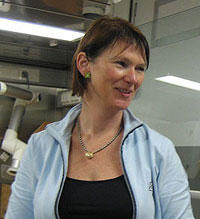Lise Øvreås

Main content
It's getting closer
Interviewwith Lise Øvreås, group leader for deep biosphere, the University of Bergen.
- Why are you joining this cruise?
It's a part of my job trying to map the biodiversity on the sea floor around the hydrothermal vents. The microorganisms are so small that they can't be seen by the eye, therefore we need other methods to know whether they are there or not. Earlier we used cultivation methods, but now we also do DNA screening. Because of that they found a third type of microorganism in 1977, the archaea. They are kind of "between the eucaryots and the bacterias", and they often grow in extreme areas like salt lakes and hydrothermal vents.
- What du you expect to find?
Since the hydrothermal vents are situated on the sea floor where the sunlight doesn't reach them, the microorganisms there must have other sourses of energy, f.ex. iron and sulfur. We can see piles of "rust" on the sea floor, a token of bacterias "eating" iron. We have a challenge in cultivating these bacterias, but I think we now have a good method. We can also see white "carpets" of sulfur eating bacterias, whitch we will analyse. Maybe we will find archaea and ammonium eating bacterias as well, but they are not of great importance this time.
- Why is it important to work with microbiology?
These bacterias are important for the metabolism of inorganic compounds in the deep sea. They are the beginning of all the nutritional chains, which means that all other animals are dependent on them. If for instance the petroleum companies start to put the CO2 leftovers from the oil industry, back to the ground, there will be a lot of "food" for the bacterias that eat it. Then they will duplicate very quickly; do we really want that? It's important for microbiologists to warn the community and the politicians before something like that is realized.
- Why did you choose microbiology?
I didn't like it at first, but now I am doing research on the microbiodiversity in f.ex. soil in Svalbard and salt lakes in Etiopia. I find it very attractive, and it brings me around the world to meet a lot of interesting people. I have also been participating in finding new species in basalt in the Soria Moria field near Jan Mayen.
